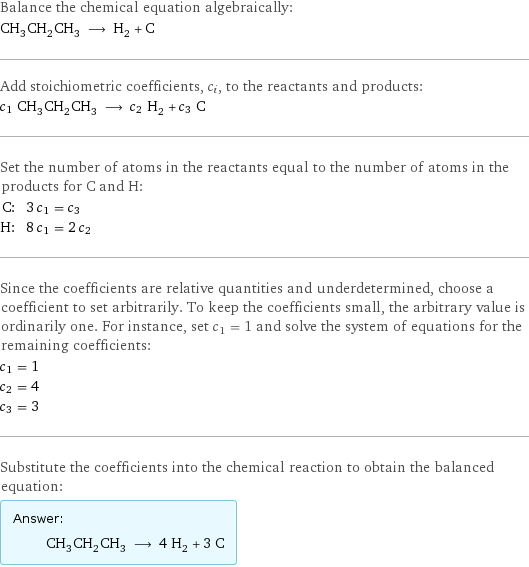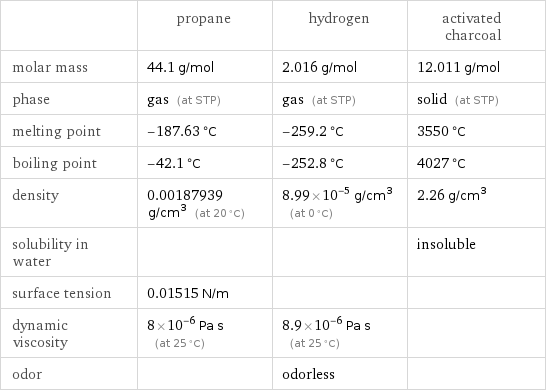Input interpretation

CH_3CH_2CH_3 propane ⟶ H_2 hydrogen + C activated charcoal
Balanced equation

Balance the chemical equation algebraically: CH_3CH_2CH_3 ⟶ H_2 + C Add stoichiometric coefficients, c_i, to the reactants and products: c_1 CH_3CH_2CH_3 ⟶ c_2 H_2 + c_3 C Set the number of atoms in the reactants equal to the number of atoms in the products for C and H: C: | 3 c_1 = c_3 H: | 8 c_1 = 2 c_2 Since the coefficients are relative quantities and underdetermined, choose a coefficient to set arbitrarily. To keep the coefficients small, the arbitrary value is ordinarily one. For instance, set c_1 = 1 and solve the system of equations for the remaining coefficients: c_1 = 1 c_2 = 4 c_3 = 3 Substitute the coefficients into the chemical reaction to obtain the balanced equation: Answer: | | CH_3CH_2CH_3 ⟶ 4 H_2 + 3 C
Structures

⟶ +
Names

propane ⟶ hydrogen + activated charcoal
Equilibrium constant
![Construct the equilibrium constant, K, expression for: CH_3CH_2CH_3 ⟶ H_2 + C Plan: • Balance the chemical equation. • Determine the stoichiometric numbers. • Assemble the activity expression for each chemical species. • Use the activity expressions to build the equilibrium constant expression. Write the balanced chemical equation: CH_3CH_2CH_3 ⟶ 4 H_2 + 3 C Assign stoichiometric numbers, ν_i, using the stoichiometric coefficients, c_i, from the balanced chemical equation in the following manner: ν_i = -c_i for reactants and ν_i = c_i for products: chemical species | c_i | ν_i CH_3CH_2CH_3 | 1 | -1 H_2 | 4 | 4 C | 3 | 3 Assemble the activity expressions accounting for the state of matter and ν_i: chemical species | c_i | ν_i | activity expression CH_3CH_2CH_3 | 1 | -1 | ([CH3CH2CH3])^(-1) H_2 | 4 | 4 | ([H2])^4 C | 3 | 3 | ([C])^3 The equilibrium constant symbol in the concentration basis is: K_c Mulitply the activity expressions to arrive at the K_c expression: Answer: | | K_c = ([CH3CH2CH3])^(-1) ([H2])^4 ([C])^3 = (([H2])^4 ([C])^3)/([CH3CH2CH3])](../image_source/e1262df8cb599bdefaf7c4faae7cfbb8.png)
Construct the equilibrium constant, K, expression for: CH_3CH_2CH_3 ⟶ H_2 + C Plan: • Balance the chemical equation. • Determine the stoichiometric numbers. • Assemble the activity expression for each chemical species. • Use the activity expressions to build the equilibrium constant expression. Write the balanced chemical equation: CH_3CH_2CH_3 ⟶ 4 H_2 + 3 C Assign stoichiometric numbers, ν_i, using the stoichiometric coefficients, c_i, from the balanced chemical equation in the following manner: ν_i = -c_i for reactants and ν_i = c_i for products: chemical species | c_i | ν_i CH_3CH_2CH_3 | 1 | -1 H_2 | 4 | 4 C | 3 | 3 Assemble the activity expressions accounting for the state of matter and ν_i: chemical species | c_i | ν_i | activity expression CH_3CH_2CH_3 | 1 | -1 | ([CH3CH2CH3])^(-1) H_2 | 4 | 4 | ([H2])^4 C | 3 | 3 | ([C])^3 The equilibrium constant symbol in the concentration basis is: K_c Mulitply the activity expressions to arrive at the K_c expression: Answer: | | K_c = ([CH3CH2CH3])^(-1) ([H2])^4 ([C])^3 = (([H2])^4 ([C])^3)/([CH3CH2CH3])
Rate of reaction
![Construct the rate of reaction expression for: CH_3CH_2CH_3 ⟶ H_2 + C Plan: • Balance the chemical equation. • Determine the stoichiometric numbers. • Assemble the rate term for each chemical species. • Write the rate of reaction expression. Write the balanced chemical equation: CH_3CH_2CH_3 ⟶ 4 H_2 + 3 C Assign stoichiometric numbers, ν_i, using the stoichiometric coefficients, c_i, from the balanced chemical equation in the following manner: ν_i = -c_i for reactants and ν_i = c_i for products: chemical species | c_i | ν_i CH_3CH_2CH_3 | 1 | -1 H_2 | 4 | 4 C | 3 | 3 The rate term for each chemical species, B_i, is 1/ν_i(Δ[B_i])/(Δt) where [B_i] is the amount concentration and t is time: chemical species | c_i | ν_i | rate term CH_3CH_2CH_3 | 1 | -1 | -(Δ[CH3CH2CH3])/(Δt) H_2 | 4 | 4 | 1/4 (Δ[H2])/(Δt) C | 3 | 3 | 1/3 (Δ[C])/(Δt) (for infinitesimal rate of change, replace Δ with d) Set the rate terms equal to each other to arrive at the rate expression: Answer: | | rate = -(Δ[CH3CH2CH3])/(Δt) = 1/4 (Δ[H2])/(Δt) = 1/3 (Δ[C])/(Δt) (assuming constant volume and no accumulation of intermediates or side products)](../image_source/580c73497fcf8bfc4d283152db1a629a.png)
Construct the rate of reaction expression for: CH_3CH_2CH_3 ⟶ H_2 + C Plan: • Balance the chemical equation. • Determine the stoichiometric numbers. • Assemble the rate term for each chemical species. • Write the rate of reaction expression. Write the balanced chemical equation: CH_3CH_2CH_3 ⟶ 4 H_2 + 3 C Assign stoichiometric numbers, ν_i, using the stoichiometric coefficients, c_i, from the balanced chemical equation in the following manner: ν_i = -c_i for reactants and ν_i = c_i for products: chemical species | c_i | ν_i CH_3CH_2CH_3 | 1 | -1 H_2 | 4 | 4 C | 3 | 3 The rate term for each chemical species, B_i, is 1/ν_i(Δ[B_i])/(Δt) where [B_i] is the amount concentration and t is time: chemical species | c_i | ν_i | rate term CH_3CH_2CH_3 | 1 | -1 | -(Δ[CH3CH2CH3])/(Δt) H_2 | 4 | 4 | 1/4 (Δ[H2])/(Δt) C | 3 | 3 | 1/3 (Δ[C])/(Δt) (for infinitesimal rate of change, replace Δ with d) Set the rate terms equal to each other to arrive at the rate expression: Answer: | | rate = -(Δ[CH3CH2CH3])/(Δt) = 1/4 (Δ[H2])/(Δt) = 1/3 (Δ[C])/(Δt) (assuming constant volume and no accumulation of intermediates or side products)
Chemical names and formulas

| propane | hydrogen | activated charcoal formula | CH_3CH_2CH_3 | H_2 | C Hill formula | C_3H_8 | H_2 | C name | propane | hydrogen | activated charcoal IUPAC name | propane | molecular hydrogen | carbon
Substance properties

| propane | hydrogen | activated charcoal molar mass | 44.1 g/mol | 2.016 g/mol | 12.011 g/mol phase | gas (at STP) | gas (at STP) | solid (at STP) melting point | -187.63 °C | -259.2 °C | 3550 °C boiling point | -42.1 °C | -252.8 °C | 4027 °C density | 0.00187939 g/cm^3 (at 20 °C) | 8.99×10^-5 g/cm^3 (at 0 °C) | 2.26 g/cm^3 solubility in water | | | insoluble surface tension | 0.01515 N/m | | dynamic viscosity | 8×10^-6 Pa s (at 25 °C) | 8.9×10^-6 Pa s (at 25 °C) | odor | | odorless |
Units
